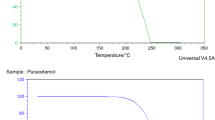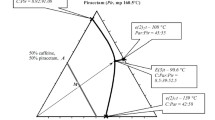Abstract
Many drug candidates are poorly soluble. The formation of solid dispersion can improve their solubility, consequently their bioavailability. For this purpose, the use of eutectic mixtures is well known in the pharmaceutical field. At the eutectic composition, both components are in reduced particle size and well dispersed. In this work, we focus on the combination of paracetamol, aspirin, and caffeine, which is highly effective for the treatment of migraine headache pain. We have reinvestigated the paracetamol–caffeine, aspirin–caffeine, and paracetamol–aspirin phase equilibria diagrams taking into account the polymorphism of caffeine, paracetamol, and aspirin. The three phase diagrams are determined using X-ray diffraction and the differential scanning calorimetry from the binary mixtures. It is concluded that the paracetamol–caffeine and aspirin–caffeine systems are similar and exhibit two invariants, one eutectic and one metatectic. The paracetamol–aspirin phase diagram reveals the formation of one eutectic. The composition of the three eutectics formed is confirmed by the related Tamman’s triangles. No compound formation is found in the three systems.














Similar content being viewed by others
References
Laska E, Sunshine A, Zighelboim I, Roure C, Marrero I, Wanderling J, Olson N. Effect of caffeine on acetaminophen analgesia. Clin Pharmacol Ther. 1983;33(4):498–509.
Ward N, Whitney C, Avery D, Dunner D. The analgesic effects of caffeine in headache. Pain. 1991;4:151–5.
Iqbal N, Ahmad B, Janbaz KH, Gilani AH, Niazi SK. The effect of caffeine on the pharmacokinetics of acetaminophen in man. Biopharm Drug Dispos. 1995;16:481–7.
Tkachenko ML, Zhnyakina LE, Kosmyninn AS. Physicochemical investigation of paracetamol–caffeine solid mixtures. Pharm Chem J. 2003;37(8):430–2.
Lipton RB, Stewart WF, Ryan RE, Saper J, Silberstein S, Sheftell F. Caffeine in alleviating migraine headache painthree double-blind, randomized, placebo-controlled trials. Arch Neurol. 1998;55(2):210–7.
Sekiguchi K, Obi N. Studies on absorption of eutectic mixture. I. A comparison of the behavior of eutectic mixture of sulfathiazole and that of ordinary sulfathiazole in man. Chem Pharm Bull. 1961;9:866–72.
Jeanjean B, Alberola S, Terol A, Sablon F. Contribution à l’étude des associations paracetamol–théophilline et paracétamol–caféine. Ann Pharm Fr. 1979;37(3–4):95–100.
Chow YP, Repta AJ. Complexation of acetaminophen with methyl xanthines. J Pharm Sci. 1972;61(9):1454–8.
Tkachenko ML. Behavior of some eutectic drug compositions under accelerated aging conditions. Pharm Chem J. 2002;36(12):683–5.
Bi M, Hwang SJ, Morris KR. Mechanism of eutectic formation upon compaction and its effects on tablet properties. Thermochim Acta. 2003;404:213–26.
Sangster J. Phase diagrams and thermodynamic properties of binary systems of drugs. J Phys Chem. 1999;28(4):889–930.
Klimova K, Leitner J. DSC study and phase diagrams calculation of binary systems of paracetamol. Thermochim Acta. 2012;550:59–64.
Higuchi T, Zuck DA. Investigation of some complexes formed in solution by caffeine. J Am Pharm Assoc. 1953;42:138–45.
Khalil SA, Moustafa MA, Ghaly GM, Gouda MW, Motawi MW. In vitro availability of some salicylates from their caffeine complexes. Can J Pharm Sci. 1975;10:83–8.
Lee KC, Hersey JA. Complexation of aspirin by caffeine. Aust J Pharm Sci. 1979;8(2):57–60.
El-Bana HM. Solid dispersion of pharmaceutical ternary systems I: phase diagram of aspirin–acetaminophen–urea system. J Pharm Sci. 1977;67(8):1109–11.
Jain H, Khomane KS, Bansal AK. Implication of microstructure on the mechanical behaviour of an aspirin–paracetamol eutectic mixture. CrystEngComm. 2014;16:8471–8.
Watters KL, Beal GD. Notes on the water content of crystalline caffeine. J Am Pharm Assoc. 1946;35:12–4.
Sutor DJ. The structure of the pyrimidines and purines. VII. The crystal structure of caffeine. Acta Cryst. 1958;11:453–8.
Gerdil R, March RE. On the arrangement of the water molecules in the crystal structure of caffeine. Acta Cryst. 1960;13:166–7.
Both H, Cammenga K. Composition, properties, stability and thermal dehydration of crystalline caffeine hydrate. Thermochim Acta. 1980;40:29–39.
Bogardus JB. Crystalline anhydrous–hydrate phase changes of caffeine and theophylline in solvent–water mixtures. J Pharm Sci. 1983;72:837–8.
Suzuki E, Shirotani K, Tsuda Y, Sekiguchi K. Water content and dehydration behaviour of crystalline caffeine hydrate. Chem Pharm Bull. 1985;33:5028–35.
Pirttimaki J, Laine E. The transformation of anhydrate and hydrate forms of caffeine at 100% RH and 0% RH. Eur J Pharm Sci. 1994;1:203–8.
Griesser UJ, Burger A. The effect of water vapor pressure on desolvation kinetics of caffeine 4/5 hydrate. Int J Pharm. 1995;20:83–93.
Edwards HGM, Lawson E, De Matas M, Shields L, York P. Metamorphosis of caffeine hydrate and anhydrous caffeine. J Chem Soc Perkin Trans. 1997;2:1985–90.
Dichi E, Legendre B, Sghaier M. Physico-chemical characterization of a new polymorph of caffeine. J Therm Anal Calorim. 2014;115(2):1551–61.
Lehmann Ch, Stowasser F. The crystal structure of anhydrous β-caffeine as determined from X-ray powder-diffraction data. Chem Eur J. 2007;13:2908–11.
Enright GD, Terskikh VV, Brouwer DH, Ripmeester JA. The structure of two anhydrous polymorphs from single-crystal diffraction and ultrahigh-field solid-state 13C NMR spectroscopy. Cryst Growth Des. 2007;7(8):1406–10.
Derollez P, Correia NT, Danède F, Capet F, Affouard F, Lefebvre J, Descamps M. Ab initio structure determination of the high-temperature phase of anhydrous caffeine by X-ray powder diffraction. Acta Crystallogr B. 2005;61:329–34.
Carlucci L, Gavezzotti A. Molecular recognition and crystal energy landscapes: an X-ray and computational study of caffeine and other methylxanthines. Chem Eur J. 2005;11(1):271–9.
Egawa T, Kamiya A, Takeuchi H, Konaka S. Molecular structure of caffeine as determined by gas electron diffraction aided by theoretical calculations. J Mol Struct. 2006;825:151–7.
Sabon F, Alberola S, Térol A, Jeanjean B. Sur le polymorphisme et la solubilité. Travaux de la Société de pharmacie de Montpellier. 1979;39:19–24.
Bothe H, Cammenga HK. Phase transitions and thermodynamic properties of anhydrous caffeine. J Therm Anal Calorim. 1979;16:267–75.
Cesaro A, Starec G. Thermodynamic properties of caffeine crystal forms. J Phys Chem. 1980;84:1345–6.
Epple M, Cammenga HK, Sarge SM, Diedrich R, Balek V. The phase transformation of caffeine: investigation by dynamic X-ray diffraction and emanation thermal analysis. Thermochim Acta. 1995;250:29–39.
Lehto VP, Laine E. A kinetic study of polymorphic transition of anhydrous caffeine with microcalorimeter. Thermochim Acta. 1998;317:47–58.
Griesser UJ, Szelagiewicz M, Hofmeir UCh, Pitt C, Cianferan S. Vapor pressure and heat of sublimation of crystal polymorphs. J Therm Anal Calorim. 1999;57:45–60.
Haisa M, Kashino S, Kawai R, Maeda H. The monoclinic form of p-hydroxyacetanilide. Acta Crystallogr B. 1976;32:1283–5.
Haisa M, Kashino S, Maeda H. The orthorhombic form of p-hydroxyacetanilide. Acta Crystallogr B. 1974;30:2510–2.
Nichols G, Frampton CS. Physicochemical characterization of the orthorhombic polymorph of paracetamol crystallized from solution. J Pharm Sci. 1998;87:684–93.
Naumov DY, Vasilchenko A, Howard JAK. The monoclinic form of acetaminophen at 150 K. Acta Crystallogr C. 1998;54:653–5.
Di Martino P, Guyot-Hermann AM, Conflant P, Drache M, Guyot JC. A new pure paracetamol for direct compression: the orthorhombic form. Int J Pharm. 1996;128:1–8.
Sohn YT. Study on the polymorphism of acetaminophen. J Kor Pharm Sci. 1990;20:97–104 (abstract).
Bürger A. Zur interpretation von polymorphie-untersuchungen. Act Pharm Technol. 1982;28:1–20.
Yu L. Inferring thermodynamic stability relationship of polymorphs from melting data. J Pharm Sci. 1995;84:966–74.
Sacchetti M. Thermodynamic analysis of DSC data for acetaminophen polymorphs. J Therm Anal Calorim. 2001;63:345–50.
Xu F, Sun LX, Tan ZC, Liang JG, Zhang T. Adiabatic calorimetry and thermal analysis on acetaminophen. J Therm Anal Calorim. 2006;83:187–91.
Boldyreva EV, Drebushchak VA, Paukov IE, Kovalevskaya YA, Drebushchak TN. DSC and adiabatic calorimetry study of the polymorphs of paracetamol. J Therm Anal Calorim. 2004;77:607–23.
Espeau P, Ceolin R, Tamarit JL, Perrin MA, Gauchi JP, Leveiller F. Polymorphism of paracetamol: relative stabilities of the monoclinic and orthorhombic phases inferred from topologica pressure–temperature and temperature–volume phase diagrams. J Pharm Sci. 2005;94:524–39.
Perlovich GL, Volkova TV, Bauer-Brandl A. Polymorphism of paracetamol relative stability of the monoclinic and orthorhombic phase revisited by sublimation and solution calorimetry. J Therm Anal Calorim. 2007;89:767–74.
Ledru J, Imrie CT, Pulham CR, Ceolin R, Hutchinson JM. High pressure differential scanning calorimetry investigations on the pressure dependence of the melting of paracetamol polymorphs I and II. J Pharm Sci. 2007;96(10):2784–94.
Perrin MA, Neumann MA, Elmaleh H, Zaske L. Crystal structure determination of the elusive paracetamol form III. Chem Commun. 2009;22:3181–3.
Di Martino P, Conflant P, Drache M, Huvenne JP, Guyot-Hermann AM. Preparation and physical characterization of forms II and III of paracetamol. J Therm Anal Calorim. 1997;48(3):447–58.
Burleya JC, Duera MJ, Steina RS, Vrcelj RM. Enforcing Ostwald’s rule of stages: isolation of paracetamol forms III and II. Eur J Pharm Sci. 2007;31:271–6.
Neumann MA, Perrin MA. Can crystal structure prediction guide experimentalists to a new polymorph of paracetamol? CrystEngComm. 2009;11:2475–9.
Di Martino P, Palmieri GP, Martelli S. Molecular mobility of the paracetamol amorphous form. Chem Pharm Bull. 2000;48(8):1105–8.
Gunawan L, Johari GP, Shanker RM. Structural relaxation of acetaminophen glass. Pharm Res. 2006;23(5):967–79.
Nanubolu JB, Burley JC. Investigating the recrystallization behavior of amorphous paracetamol by variable temperature raman studies and surface raman mapping. Mol Pharm. 2012;9:1544–58.
Parkin A, Parsons S, Pulham CR. Paracetamol monohydrate at 150 K. Acta Cryst E. 2002;58:1345–7.
Fabbiani FPA, Allan DR, David WIF, Moggach SA, Parsons S, Pulham CR. High-pressure recrystallization—a route to new polymorphs and solvates. CrystEngComm. 2004;6(82):504–11.
McGregor PA, Allan DR, Parsons S, Pulham CR. Preparation and crystal structure of a trihydrate of paracetamol. J Pharm Sci. 2002;91:1308–11.
Fabbiani FPA, Allan DR, Dawson A, David WIF, McGregor PA, Oswald IDH, Parsons S, Pulham CR. Pressure-induced formation of a solvate of paracetamol. Chem Commun. 2003;24:3004–5.
Vrcelj RM, Clark NIB, Kennedy AR, Sheen DB, Shepherd EEA, Sherwood JN. Two new paracetamol/dioxane solvates—a system exhibiting a reversible solid-state phase transformation. J Pharm Sci. 2003;92(10):2069–73.
Oswald IDH, Allan DR, McGregor PA, Motherwell WDS, Parsons S, Pulham CR. The formation of paracetamol (acetaminophen) adducts with hydrogen-bond acceptors. Acta Cryst. 2002;B58:1057–66.
Oswald IDH, Motherwell WDS, Parsons S, Pulham CR. A paracetamol–morpholine adduct. Acta Cryst. 2002;E58:1290–2.
Andre V, da Piedade MFM, Duarte MT. Revisiting paracetamol in a quest for new co-crystals. CrystEngComm. 2012;14:5005–14.
Crowell EL, Dreger ZA, Gupta YM. High-pressure polymorphism of acetylsalicylic acid (aspirin): Raman spectroscopy. J Mol Struct. 2015;1082:29–37.
Wheatley PJ. The crystal and molecular structure of aspirin. J Chem Soc. 1964;1163:6036–48.
Kim Y, Machida K, Taga T, Osaki K. Structure redetermination and packing analysis of aspirin crystal. Chem Pharm Bull. 1985;33:2641–7.
Bond AD, Boese R, Desiraju GR. On the polymorphism of aspirin. Angew Chem Int Ed. 2007;46:615–7.
Bundgaard H. Influence of an acetylsalicylic anhydride impurity on the rate of dissolution of acetylsalicylic acid. J Pharm Pharmacol. 1974;26:535–40.
Mitchell AG, Saville DJ. The dissolution of aspirin and aspirin tablets. J Pharm Pharmacol. 1967;19:729–34.
Tawashi R. Aspirin-dissolution rates of 2 polymorphic forms. Science. 1968;160:76.
Mitchell AG, Saville DJ. The dissolution of commercial aspirin. J Pharmacol. 1969;21:28–34.
Pfeiffer RR. Aspirin polymorphism questioned. J Pharm Pharmacol. 1971;23:75–6.
Schwartzman G. Does aspirin exist in polymorphic states? J Pharm Pharmacol. 1972;24:169–70.
Mitchell AG, Milaire BL, Saville DJ, Griffiths RV. Aspirin dissolution: polymorphism, crystal habit or crystal Defects. J Pharm Pharmacol. 1971;23:534–5.
Ouvrard C, Price SL. Toward crystal structure prediction for conformationally flexible molecules: the headaches illustrated by aspirin. Cryst Growth Des. 2004;4:1119–27.
Vishweshwar P, McMahon JA, Oliveira M, Peterson ML, Zaworotko MJ. The predictably elusive form II of aspirin. J Am Chem Soc. 2005;127(48):16802–3.
Bond AD, Solanko KA, Parsons S, Redder S, Boese R. Single crystals of aspirin form II: crystallisation and stability. CrystEngComm. 2011;13:399–401.
McMahon JA. Crystal engineering of novel pharmaceutical forms. Tampa: University of South Florida; 2006.
Della Gatta G, Richardson MJ, Sarge SM, Stolen S. Standards, calibration, and guidelines in microcalorimetry. Pure Appl Chem. 2006;78:1455–76.
Author information
Authors and Affiliations
Corresponding author
Rights and permissions
About this article
Cite this article
Dichi, E., Sghaier, M. & Guiblin, N. Reinvestigation of the paracetamol–caffeine, aspirin–caffeine, and paracetamol–aspirin phase equilibria diagrams. J Therm Anal Calorim 131, 2141–2155 (2018). https://doi.org/10.1007/s10973-017-6855-6
Received:
Accepted:
Published:
Issue Date:
DOI: https://doi.org/10.1007/s10973-017-6855-6




